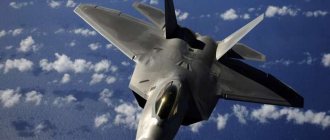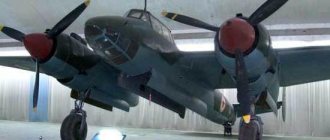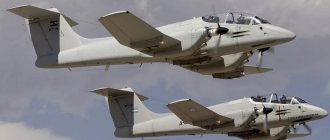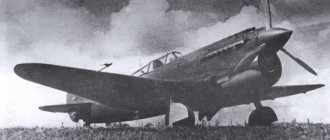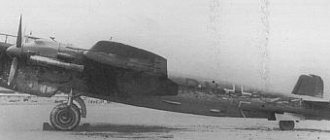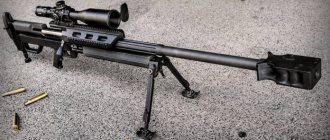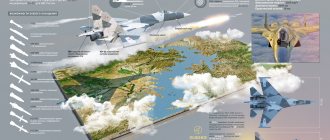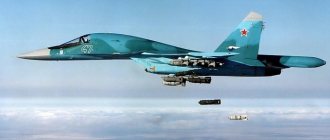MiG-1 and MiG-3
Soviet fighter Mig-1.
The first MiG was designed in 1939. In 1941, about 25 MiG-3 fighters rolled off the assembly lines of factories in the USSR per day.
MiG-3 is a legendary fighter of the Great Patriotic War.
MiG-1 and MiG-3 fighters made a significant contribution to victory in the war against the Nazi invaders. MiG-3 aircraft were in service with two elite fighter regiments, and the most experienced test pilots fought on them. It was on the MiG-3 that the famous Soviet ace A.I. Pokryshkin won his first victory by shooting down a German Me-109E. The high standardization and maintainability of MiGs ensured their long service life even in wartime conditions. After the war, MiG-3 fighters were in service with air defense fighter regiments for a long time.
Design features of the MiG-1 fighter
The aircraft had a design that was very similar to the I-16 aircraft, but there were many differences. The fuselage of the new fighter was made according to the structural layout. The tail section of the vehicle was made as a semi-monocoque, which had additional fastenings made of wooden stingers and frames. The middle and bow compartments of the device were represented by a removable motor mount, which was welded from pipes and covered with duralumin sheets.
MiG-1 video
The center section of the aircraft was manufactured as an all-metal structure. In addition to metals, the design of the machine included wood, from which the wing consoles were made, which led to an increase in weight and less reliability of the wing itself. The designers had to use wood due to an acute shortage of metals.
The power plant was represented by a fairly powerful, but at the same time heavy, AM-35 engine, which should work perfectly at high altitudes with low oxygen content in the air. This engine could produce a power of 1200 horsepower, but it was achieved at altitudes of more than 5 kilometers. The most effective flight was at an altitude of 7 kilometers or more, where the MiG-1 aircraft could reach maximum speed indicators. The closer to the surface of the earth the device flew, the worse the flight characteristics were.
As for the fuel system, in the MiG-1 type aircraft it was represented by two tanks, which were located in the center section of the wings. Further aircraft of this type were equipped with additional tanks for greater range.
In addition to its advantages, the aircraft also had disadvantages, the biggest being the design of the pilot's canopy, which tilted to one side. This opening scheme resulted in the pilot being unable to open the canopy during the flight. The vents, which were supposed to provide ventilation to the pilot's cabin, worked ineffectively and could not provide normal ventilation and cooling in the cabin. These shortcomings were improved, and production MiG-1 aircraft were equipped with a canopy that moved back. The designers also provided a more efficient ventilation and cooling system.
All the shortcomings of the MiG-1 aircraft were identified and improved by the designers. These metamorphoses led to the emergence of a new fighter, which was designated as the MiG-3, which also replaced the MiG-1.
MiG-15
The first jet aircraft MiG-15.
On December 30, 1947, a prototype of the first jet aircraft took off. It also became the first Soviet serial fighter with a swept (35 degree) wing. Another innovation implemented in this model is the chassis with a new wheel. The distinctive features of the MiG-15 were reliability and simplicity of design, high flight and operational qualities and powerful weapons - one 37 mm cannon and two 23 caliber cannons. Thanks to its rate of climb, maximum speed and flight range, this fighter became the best Soviet fighter of that time. At an altitude of 5000 m, the speed of the MiG-15 was 1028 km/h, and at an altitude of 2620 m – 1042 km/h. Serial production of the MiG-15 and its various modifications was carried out at nine (!) aircraft factories of the Soviet Union. A total of 13,131 fighters of this type were built. The MiG-15 was mass-produced in Poland and Czechoslovakia under Soviet license. In total, more than 18 thousand of these aircraft were produced in the world, which is a record in the class of jet fighters.
It is worth noting that today a stylish luxury civilian “fighter” Saker S-1 has already appeared.
Comments from officials
There has not yet been any information in official sources about whether this new aircraft has been created or not. It is quite possible that it is already in the test hangars of the Design Bureau named after. Mikoyan and is waiting in the wings. However, this remains classified information, and to date there is no information about technical characteristics, appearance and operational data.
It is only known that the MIG-41 fighter is a modern innovative development of a modern interceptor capable of replacing the MIG-31. Due to its secrecy, work on the machine was called “the most secret idea of the Russian defense industry.”
There are quite a lot of discussions on this topic on specialized forums, but they all end with unsubstantiated forecasts and assumptions.
According to Sergei Korotkov, President of the Russian United Aircraft Corporation, this year many separate projects were completed to assemble the fighter.
He once again emphasized that a modern interceptor fighter is being created to replace the outdated model that has been in use since 1975. In addition, it was noted that not only specialists from the Design Bureau are working on the creation of the aircraft. Mikoyan, but also a number of representatives of other enterprises related to the Russian defense industry.
Development is being carried out according to a pre-order received from the Russian Defense Ministry, since in fact the task is to replace the obsolete MIG-31 with a new modern modification. Korotkov did not provide any other information.
Colonel General of the Russian Air Force Viktor Bondarev expresses himself as follows: “Work on the project is being carried out quite actively, at the moment the main actions are carried out in the person of scientific researchers who submit design documentation for the start of experimental design work.”
Also, the commander-in-chief emphasized that the modern MIG-41 interceptor fighter will be put into service in 2025.
Several years ago, a test pilot commented on the situation by saying that a new fighter should have appeared at the turn of the century.
MiG-19
The first supersonic aircraft MiG-19.
The MiG-19 is the world's first aircraft capable of reaching supersonic speed in horizontal flight when launched from the ground. After successful tests of this fighter, various modifications with enhanced weapons appeared. Thus, blocks with unguided rockets were suspended on one of the modifications, and the MiG-19PM was armed with K-5M guided air-to-air missiles for the first time in the USSR.
In total, during serial production at the factories in Novosibirsk and Gorky, 1890 MiG-19 fighters of all modifications were produced. Fighters were produced under license in China and Czechoslovakia. Although the MiG-19 was produced in a large series, another supersonic Soviet fighter, the MiG-21, received mass recognition.
History of MiG fighter aircraft
Since 1942, Mikoyan has been the director and chief designer of the newly created pilot plant No. 155 (OKB-155). In 1941-1945, under the leadership of Mikoyan, a number of fighters with high performance characteristics were created, including the I-250 with a combined power plant.
Artem Mikoyan is one of the pioneers of jet aviation in the USSR. After the war, Mikoyan developed high-speed and supersonic front-line jet aircraft, many of which were produced in large series and were in service with the Air Force for a long time. Among them are the MiG-9, MiG-15, MiG-17 (which reached the speed of sound), MiG-19 (the first production domestic supersonic fighter), MiG-21 (with a thin profile delta wing and a flight speed twice the speed of sound).
Since 1956, Mikoyan has been the general designer. In 1958–1963, the OKB created a number of prototype aircraft, on which new technical solutions were tested, which were used in the creation of promising front-line fighters and air defense interceptors. The last aircraft created under the leadership of Mikoyan were the MiG-23 fighter (the first in the USSR with a variable sweep of the entire wing in flight) and the MiG-25 interceptor fighter with a flight speed three times the speed of sound. Mikoyan created his own school in aircraft construction and trained many highly qualified designers. More than 50 world records have been set on aircraft developed under the leadership of Artem Mikoyan.
For example, in 1967, two world records were set. Pilot Alexander Fedotov on a MiG-25 fighter (the record version of the MiG-25 was registered in the Fédération Aéronautique Internationale as E-266) with a load of 2 tons reached 30,010 m - no other aircraft in the world with a load has ever reached such a height. Pilot Petr Ostapenko, using the same fighter and with the same mass of cargo, flew over a distance of 1000 km at a speed of 2910 km/h. At the same time, pilot Mikhail Komarov flew 500 km at an average speed of 2930 km/h. This record significantly exceeded that set by the best US Air Force fighter, the F-12, whose speed was 2644 km/h.
In March 1971, Rostislav Belyakov was appointed general designer. The 1970s were marked by the creation of the MiG-31 all-altitude long-range interceptor and the MiG-29 light multirole fighter. According to aviation experts, this fighter is the best fighter in its class in the world at the end of the 20th century. The high maneuverability and thrust-to-weight ratio of the MiG-29 allow vertical climb with acceleration, and the weapons control system ensures detection of targets and use of weapons both at ranges exceeding visual visibility and in close combat. New records were set on the MiG-25 aircraft (modification E-266): for flight speed - one world record in 1973, world records for women in 1975, 1977, 1978; in flight altitude - two world records in 1973, one absolute world record in 1973, three world records in 1977, a world record for women in 1977; in climb rate - three world records in 1973 and three world records in 1975.
In 1997, Rostislav Belyakov left his post, and two years later he was awarded the title of Honorary General Designer of MiG aircraft.
Today Inzhenerny is part of the Open Joint Stock Company Russian Aircraft Corporation MiG, created in 1999. Director of the Engineering Department is Vladimir Ivanovich Barkovsky.
Over many years of work, one of the most famous Russian design bureaus developed about 450 combat aircraft projects, of which 170 were implemented, and 94 were mass-produced. In total, about 45 thousand MiG aircraft were built at domestic aircraft factories, of which 11 thousand were exported. Over 14 thousand MiG fighters have been produced abroad under license. MiG aircraft protected the skies of more than 40 countries from aggression. Among them are such famous fighters as MiG-15, MiG-17, MiG-19, MiG-21, MiG-23, MiG-25, MiG-29, MiG-31.
MiG-21
The first Soviet aircraft with a delta wing, the MiG-21.
The MiG-21 multirole fighter was developed in the mid-1950s. This is the first Soviet aircraft with a delta wing and the most common supersonic combat aircraft in the world. The main structural material for this aircraft was aluminum alloy, and the main type of connection was riveting. MiG-21 fighters demonstrated their excellent combat qualities during the Vietnam War, the Indo-Pakistani conflict, the Arab-Israeli war, and during combat operations in Angola, Afghanistan and other zones of armed conflict.
On August 15, 1966, Iraqi pilot Munir Redfa, who once underwent training in the USSR, hijacked a MiG-21 from Iraq to Israel. The hijacking was carried out by prior agreement with the Mossad. The flight took 25 minutes. In Israel, the plane was subjected to flight tests, and later transported to the United States for research. Today this aircraft is on display in a museum in Israel.
MiG-35
Photo: migavia.ru
This is the latest multi-role fighter of the “4++” generation, which is a further development of the MiG-29K/KUB and MiG-29M/M2 aircraft. The start of flight tests and the international presentation of the vehicle took place in January 2022, and its factory tests were completed in December of the same year.
The first contract for the supply of six MiG-35s until 2023 was signed by Deputy Minister of Defense of the Russian Federation Alexei Krivoruchko and the head of the United Aircraft Corporation Yuri Slyusar on August 22, 2022 at the Army-2018 forum in Kubinka near Moscow. According to media sources, the Russian Aerospace Forces (VKS) will sign a contract for the supply of the next batch of 14 MiG-35 fighters in 2022.
Earlier, a TASS source reported that in 2022 the troops received the first two MiG-35UB (combat training), four more MiG-35S (serial) should be delivered before 2022. In total, according to two contracts, the troops will receive 20 MiG-35 fighters by 2023. Serial production of this aircraft has already started.
Air Force Commander - Deputy Commander-in-Chief of the Aerospace Forces (VKS) Sergei Dronov said that state tests of the new light Russian fighter MiG-35 are planned to be completed at the end of 2022. He noted that the MiG-35 differs from the Su-30SM and Su-35S fighters in service in its efficiency. “The cost of its flight hour is approximately one and a half times lower than that of modern Sukhoi aircraft,” said Dronov.
In addition, the director of the Federal Service for Military-Technical Cooperation (FSMTC) Dmitry Shugaev announced the receipt of applications from several countries for the purchase of the MiG-35.
The fighter is designed to operate in zones of high-intensity armed conflicts in conditions of a dense and echeloned enemy air defense system. It is capable of performing complex multi-role missions in a constantly changing operational and tactical environment over the battlefield and hitting air, ground and surface targets.
On the birthday of its design bureau, the Russian aircraft manufacturing corporation MiG published an official statement stating that work is underway in Russia to create aviation complexes based on high-speed unmanned aerial vehicles. “It is expected that the aircraft being developed will have a high combat potential and will be able to be used in a single system with both MiG-35 aircraft and other aviation systems,” the statement says.
Since its founding in the OKB im. A.I. Mikoyan developed more than 400 types and modifications of aircraft and aircraft. The total volume of production of MiG aircraft by serial aircraft factories exceeded 55 thousand units. Aircraft of this family have set more than 100 world records for speed, altitude and rate of climb. Whether the new projects of the Mikoyan Design Bureau will be able to make another revolution and take their rightful place in the aviation history of the 21st century, time will tell.
MiG-23
Multirole fighter MiG-23.
The MiG-23 is a multi-role fighter with a variable-sweep wing. These aircraft could fly at angles of attack up to 24-26 degrees, which gave them certain advantages over Western-made fighters of the second and third generations. But with the advent of fourth-generation fighters in the West, in particular the F-16, the superiority was lost.
These fighters took part in many armed conflicts in the 1980s. Thus, a regiment of MiG-23MLD aircraft covered Kabul, and later Bagram. As a rule, in Afghanistan these aircraft “worked” against ground targets. Each successful combat mission was indicated by a small white star on the forward fuselage. There is a known case of an air battle when a MiG-23MLD shot down a Pakistani F-16A with an R-60M missile.
In 1984, a squadron of 14 MiG-23MLDs was based at the Vietnamese military base at Cam Ran, covering Soviet Tu-16 and Tu-95 bombers over the sea. MiG-23 fighters have shot down reconnaissance balloons in the Moscow region more than once. It is a known fact that an air regiment based at the Tunoshna airfield (near Yaroslavl) intercepted a UFO
MiG-25P
MiG-25P interceptor aircraft.
Serial production of MiG-25P interceptor aircraft began in 1966, and in the early 1970s, MiG-25P began to arrive in fighter aviation units of the air defense forces. This aircraft became the basis for the creation of the MiG-25PDSL aircraft with devices for ejecting false thermal targets and with a container with a jamming station, the MiG-25PDZ aircraft with an in-flight refueling system, and the MiG-25M aircraft with uprated R15BF2-300 engines with a thrust of 13,500 kgf.
Versions
On that day, training flights took place in the Far Eastern fighter aviation regiment of the Soviet Air Defense Forces. In accordance with the planned task, senior lieutenant Viktor Belenko took off his MiG-25. But the car did not return to the airfield.
The regiment sounded the alarm. The first assumption is that the plane crashed. At first, the commander of the air defense forces, air marshal Evgeniy Savitsky, who was at that time on an inspection in Primorye, shared the same opinion: “Aviation is aviation. Anything can happen. Search." But I didn’t have to search for long. Soon, world agencies reported from Japan: a Soviet fighter had landed at Hakodate airport. It became clear to the command that this was Viktor Belenko’s plane.
Senior Lieutenant Belenko graduated from the Armavir Higher Military Aviation School of Pilots. He served as an instructor pilot at the Stavropol Higher Military Aviation School of Air Defense Pilots and Navigators. Then he was sent to an air defense fighter aviation regiment stationed in the Far East. Completed a training course at the Center for Combat Use and Retraining of Air Defense Aviation Flight Personnel.
The official version of the leadership of the USSR is as follows: pilot Belenko lost his orientation and, not having enough fuel for the return trip, made an emergency landing at the airport in the Japanese city of Hakodate. Of course, this could be so, but it was necessary to explain why Belenko, having found himself in Japan, soon moved to the USA.
© cia.gov Military ID of First Lieutenant Viktor Belenko, which is now kept in the CIA museum.
Soon, the Ministry of Foreign Affairs, as it seemed to Soviet diplomats, gave a “convincing” answer: they say that special methods of influence were used on the pilot - millions of Japanese television viewers saw how the police pushed Belenko into a car with a bag draped over his head. No one doubted that the American intelligence services were behind such an “invitation” of Viktor Belenko to the United States.
American version - Belenko flew to Japan for political reasons. They say that in the USSR he belonged to the military elite, he had almost everything that a young man could dream of, but he did not have the main thing - freedom. However, Belenko himself explained his action very vaguely, apparently understanding that justifying betrayal requires more compelling arguments than the desire to simply gain freedom. Already in the 1970s, Belenko published a book in which he explained his action by his reluctance to put up with numerous accidents and disasters in Soviet aviation units. Some American researchers also adhered to this version. In particular, the author of the widely known book “Unearthing Soviet Disasters,” James Oberg.
There is a third version, which is adhered to by many former colleagues of Viktor Belenko, according to which the “trigger mechanism” of this incident was the super-high-altitude and super-fast fighter-interceptor MiG-25P (NATO code designation - “Foxbat” - “Flying Fox”) developed by the Design Bureau named after A .AND. Mikoyan, but Belenko himself is a primitive traitor, and the American intelligence services organized his escape.
MiG-25
The world's fastest aircraft is the MiG-25.
Pilots say about the Soviet single-seat supersonic high-altitude interceptor MiG-25 3.2M that there are speed limits for it only on paper. This is, of course, an exaggeration, but the MiG-25 3.2M is truly the fastest aircraft in the world. This aircraft set several world speed records. True, they were not officially registered.
A MiG-25 plane hijacked by pilot Belenko.
On September 6, 1976, USSR Air Force pilot Viktor Belenko hijacked a MiG-25 to Japan. The Japanese returned the plane, but before that they dismantled it down to the smallest screw. Belenko asked for political asylum in the United States.
Experimental[edit]
- DIS/MiG-5, 1941 (escort fighter)
- MiG-6, 1940 (reconnaissance/attack aircraft)
- MiG-7, 1944
- MiG-8 Duck
, 1945 - MiG I-200, 1939, prototype MiG-1 MiG IP-201, 1941, MiG-1 converted into a test bench for an experimental machine gun.
MiG-29
MiG-29 (1972–1982)
The MiG-29 fighter and its various modifications were developed in the USSR in the period 1972–1982. The main goal of the creators of these aircraft was to achieve reliability indicators that exceeded the world level achieved at that time. Aircraft designers have also mastered a fundamentally new type of work - shaping the appearance of an aircraft at the request of a foreign customer. In total, more than 1,600 MiG-29 fighters of various modifications have been built to date. More than 800 MiG-29 fighters were exported to 30 countries.
MiG-31
Supersonic fighter-interceptor MiG-31.
The MiG-31 is a two-seat supersonic all-weather long-range fighter-interceptor designed to intercept and destroy air targets day and night, at low, extremely low, medium and high altitudes, in all weather conditions, when the enemy uses passive and active radar jamming and heat traps . A group of 4 MiG-31 interceptors can control airspace with a frontal length of up to 900 km. Maximum permissible speed at an altitude of 3000 km/h
What will the MIG-41 be like?
Today it is known that specialists from the OKB are working on the design of a modern long-range interceptor fighter. Mikoyan and the Nizhny Novgorod Aviation Design Bureau. The project was started back in 2013 after a written order from the Commander-in-Chief of the Aerospace Forces, which after some time was duplicated by an order of the General Staff of the Russian Armed Forces.
Information slips into the press that the new fighter will reach speeds of up to 7,000 km/h.
To date, no aircraft of this type can accelerate to such limits.
For comparison, you can use the table, which shows the fastest fighters in the world.
| Fighter model | Country of Origin | The country in which it is in service | Maximum speed, km/h | Number of units produced |
| Raphael | France | France | 1 900 | 195 |
| Saab JAS 39 Gripen | Sweden | Czech Republic, Hungary, Thailand, South Africa, Sweden | 2 200 | 270 |
| MIG-29 | Russia | Russia | 2 415 | 1,500, production continues |
| MIG-23 | Russia | India, Syria, Libya | 2 445 | 3 630 |
| Typhoon | Germany | UK, Germany, Spain, Saudi Arabia, Italy, Austria | 2 450 | About 500 |
| SU-27 | Russia | Russia | 2 476,4 | 809 |
| Grumman F-14 Tomcat | USA | USA | 2 485 | 712 |
| McDonnell Douglas F-15 Eagle | USA | USA, Israel, Saudi Arabia, Japan | 2 650 | 1 500 |
| MIG-25 | Russia | Russia Ukraine | 2 700 | About 1,200 |
| MIG-31 | Russia | Russia | 3 000 | 519 |
As can be seen from the information presented, domestic developments are unparalleled leaders today. If the speed declared for the MIG-41 matches, it will become an absolute record holder in this area.
It should not be ruled out that all of the above modifications of Russian fighters were designed at the turn of the Soviet Union, that is, at the moment the projects are more than 30 years old.

